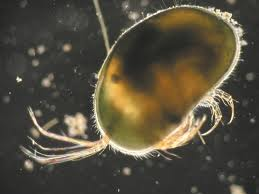Ostracoda (Crustaceans)
The Ostracoda are one of the most successful crustacean groups with approximately 8000 living species. Ostracods are generally small, ranging in length from 0.1 to 32 mm (that's smaller than a poppy seed to the size of a meatball). As indicated by its name, Gigantocypris a planktonic ostracod, is by far the largest member of this group reaching up to 32 mm. Gigantocypris's pelagic life style (continuously swimming in the open water) sets it apart from many other ostracods as well. Most other ostracods are found crawling on or burrowing into the sediments at the bottom of the ocean or lakes. A few species, for example Mesocypris sp., are also found crawling around in moist terrestrial habitats such as mosses. In these habitats, they feed on dead organic material, suspended organic particles, microscopic plants, or they are predators.
Ostracods consist of little more than a head. They have the typical five pairs of appendages on their head but only 1-3 pairs of appendages on the rest of the body. Their bivalved carapace may cause you to mistake them for tiny clams or mussels, thus the common name of "mussel shrimp". The two part, hinged carapace encloses the entire body, similar to the branchiopod Conchostraca. However, their appendages distinguish them from the conchostracans. Another feature that differentiates these groups is a lack of growth rings on the carapace. Ostracods shed the carapace with each molt, whereas the conchostracans simply add material to the carapace as they grow.
WOW thank you UCMP.



